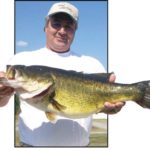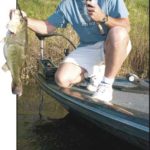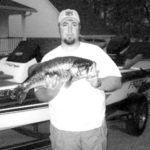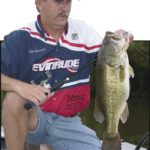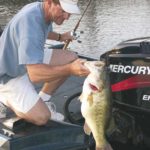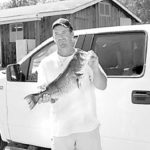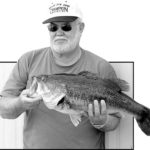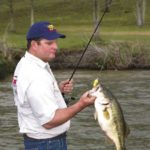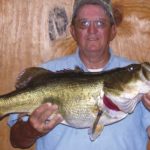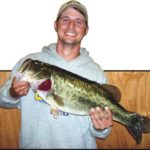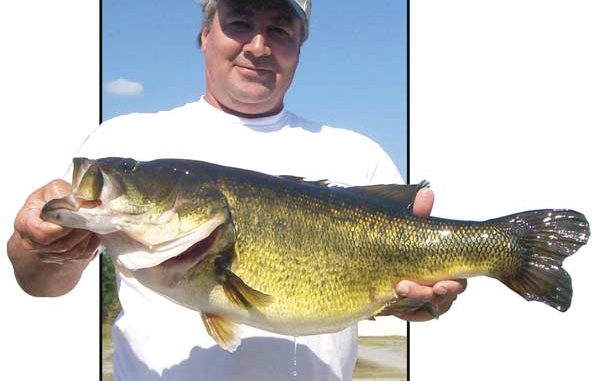
Louisiana’s trophy bass fishing has fallen on hard times in recent years, but that’s likely to change this spring, particularly on these four lakes.
Ah, the first hint of spring, whenever it comes in the next month or two, finds you with fingers trembling to tie on your favorite artificial lure with a resolve to cast and catch a “trophy” bass at a body of water somewhere in Louisiana. The sun glows golden as it slowly rises over the horizon, softly illuminating some of the bassiest looking water you’ve ever laid eyes on. Birds are chirping. Occasionally, a fish breaks the surface.
Up north at the time, it’s still winter. Outdoorsmen from Arkansas on up and out are shivering and suffering from bad cases of cabin fever. They’re just dreaming of the chance you’ve got — while wearing a light coat that’ll probably get shed later in the day — to put a double-digit bass in the boat.
But, where, oh where, is that body of water somewhere in Louisiana? Where is the best chance this spring to catch the biggest bass of your life without going outside the Louisiana state lines?
Ask the state Department of Wildlife and Fisheries’ Gary Tilyou, who heads up the freshwater division of one of the most progressive agencies in the nation, and he ticks off three lakes that should give up quality bass in late February, March, April and early May. With little hesitation, the experienced biologist named Toledo Bend, Caney Lake southwest of Chatham and Chicot Lake near Ville Platte.
With all due respect, Mike Wood, biologist manager for the department’s district based in Monroe, who also oversees Caney Lake, agreed on the freshwater division chief’s top choices but had to throw Poverty Point State Park Reservoir into the mix for anglers to seriously consider for a trophy hunt early in 2008. He’s impressed with the relatively new 3,000-acre lake about three miles from Delhi.
“I do shocking (electrofishing) samples over there, and my eyes just pop out,” Wood said. “What I see in our samples first is high numbers, and then big bass, which is an unusual combination. In this lake, I’ve seen both. We shocked one last fall that was 10-7. This fish looked like it was ready to pop, as a spawner or something, but it wasn’t. It was just rolling fat!
“Normally, we don’t shock big fish. Usually, we catch 6- and 8-pounders on a common basis. I’m telling you, it’s one (lake) if you dedicate a little time to go find those fish, you’ll have it to yourself … until people find out.”
He called it an “untapped trophy fishery.”
But, oh, it’s hard to beat the grandpa of the best bassin’ waters in this state. It’s the border lake between Texas and Louisiana west of Poverty Point State Park Reservoir.
Toledo Bend
First and foremost, Tilyou said, “If I was going to go for a double-digit fish, it’d be Toledo Bend. It’s got several things going for it.”
Those plusses include a multitude of various habitats, good water quality, aquatic vegetation and a variety of water depths. As a result, bass there are less stressed than those in other waterbodies in the state, such as shallow lakes.
Another easy clue that it probably harbors more double-digit bass than other lakes, rivers or bayous in the state is simple.
“They’ve produced the most big fish that I’m aware of this year,” Tilyou said.
How big? Three weighing more than 12 pounds were entered last spring in the department’s Louisiana Lunker Bass Program that cranks up each spring, including the 14.2-pounder by Joey Lafosse on Feb. 28, 2007, according to biologist manager Ricky Yedell, who has been stationed at the lake since around 2000.
Toledo Town & Tackle’s Lunker Release Program last year yielded a record number of 10-pound-plus bass turned in by anglers who got a replica mount in return, Yedell, a 29-year veteran biologist with the state agency, said in mid-December. More than 50 were caught and registered in the program, he said, including a 13.55-pounder by Jerry Sisco on March 5, 2007.
John Dean, a fishing guide and veteran artificial lure manufacturer who writes the monthly Toledo Bend column for Louisiana Sportsman, said double-digit bass came in regularly. The spring season wasn’t the lone big bass period, he pointed out recently, as 10-pound-plus bass were caught in the summer and the fall.
Take, for example, the hawgs caught by three Teche-area anglers in 2007 at Toledo Bend. Lynn Landry of New Iberia and Chad Hazelwood of Loreauville caught 11.51- and 11.4-pound bass, respectively, last March, and Ricky Watkins of New Iberia put a 10-pounder in the boat during a Louisiana Bass Cats bass club tournament last October.
Those were just three of the double-digit fish put in the livewell last year. But it shows anglers what can be theirs even if they live, work and fish most of the time at least three hours away from the 186,000-acre manmade lake that stretches 65 miles from the dam several miles southwest of Anacoco north to Logansport.
And it’s got more than its share of bragging-sized bass, too. How else do you explain, except for sheer luck and being at the right place at the right time, that Malcolm Dugas of Coteau Holmes, who had never fished the immense lake for bass, landed a 7.15-pounder the first day of the prestigious LOBI tournament in March, went out the next day of the LOBI and came back with a 9.33-pounder?
It’s hard to steal the thunder from the Big T.
“Well, Toledo (Bend) has always been and probably always will be one of the best bass fishing lakes in the region, probably the nation,” Yedell said.
But what about a state-record bass being caught this year in Louisiana? There’s been quite a drought since the last one made an angler so proud.
Louisiana’s running on 14 years since someone reeled in a state record bass. That angler was Gregg Wiggins, who hooked and got his hands on the 15.97-pound bass in February 1994 at Caney Lake.
Tilyou said he isn’t that surprised by the prolonged dry streak. The Sportsman’s Paradise isn’t alone in long stretches between state-record bass, he said.
“I don’t know if anybody knows the answer,” he said. “It happens in every state. When was the last time you heard of a new record come out of the state of California?
“I don’t have an answer for that.”
Could Toledo Bend give up that historic bass, the heaviest ever in Louisiana?
“I believe it will. I’m surprised it hasn’t already. I keep telling people I think this lake is hitting its stride. I believe the (state-record) fish is there. People just haven’t connected with it yet,” Tilyou said.
Chances are, if the state’s biggest fish comes out of the lake this spring, or later this year, it won’t be a pure Florida bass. Yedell, who stocked 300,000 Florida bass fingerlings in the lake last year (after requesting 450,000) and has requested 1 million of the tiny fish for 2008, said he looks at it a little differently than other biologists might.
“A pure Florida’s not the best fish to reach maximum size,” he said. “The best chance is a hybrid Florida and native bass. Our percentage of Florida influence at Toledo is running around 30 percent, which is excellent.”
Florida-bass stocking began at Toledo Bend in 1994, he said.
Anyone wondering if the record-low pool levels in the early 2000s might have adversely affected the lake should be relieved to know they helped more than hurt the bass fishery at Toledo Bend. Yedell and other biologists believe fluctuations in the water level can be beneficial to the fishery in an impoundment.
“It improves spawning success, kind of like the natural cycle of a river,” Yedell said.
When the water drops out, more of the lake bottom is exposed, which becomes prime spawning “ground” when the water comes back up.
What unfolded last year probably was the best scenario anyone could ask for in light of the back-to-back-to-back years of low water conditions. The pool level was at 170.0 feet and above most of the spring and summer to benefit spawning areas, which held up long enough for young fish to survive, Yedell said, “which means about three years down the road we should have a good crop of keeper bass. We should have quite a few fish over 14 inches. Of course, that group of fish will continue to grow. After seven, eight years, they will be 10 pounds and over.”
Soft plastics, mostly watermelon/red, like wacky worms, Senkos and Zoom Brush Hogs, usually account for many of the big bass taken each spring at Toledo Bend, Yedell said. Best bet to get a bite from a “hawg” is to fish the “staging” areas near the traditional spawn sites from the dam north to the Blue Lake area, he said
Historically, he said, most of the lake’s biggest bass are caught when the water temperature’s in the low 60s and/or during the middle two weeks of March.
Caney Lake
Bass 10 pounds and over are nothing new to Caney Lake, one of the biologists’ top choices to catch trophy bass this spring. Eight of the state’s top-10 bass came from the 5,000-acre lake impounded in 1987. When it was born, the department’s biologists started an intense management campaign to complement the native bass population by stocking Florida bass.
The boom got under way in 1991 when a 13-pounder was caught at Caney Lake. Wood said that was only the beginning because the lake’s creeks had plenty of fish, but the main lake was dominated by small bass about 8 inches long. So biologists introduced threadfin shad and got the desired result — the bass fishery and the size of the fish mushroomed.
Caney Lake yielded 16 of the top 20 bass after 1992, including a 15.53-pounder by Fred Kennedy in October 1993. Then Wiggins caught the state record in February 1994.
However, the big bass bonanza ran into trouble after January 1994, when state officials responded to boaters’ and skiers’ complaints and introduced 12,000 sterile grass carp to the lake to combat what was perceived as a grass problem. Carp devoured grassbed after grassbed, and bass fishing success plummeted drastically.
Various measures to reduce the carp population put a serious dent in the numbers. Grassbeds started reappearing in coves again.
A positive sign that the lake’s bass population was on the rebound came in March 2001 when Kenneth Walker lipped a 14.39-pound bass, one that became the first Louisiana Top 20 bass since 1996.
“I’m happy to say Caney Lake is very much on the rebound,” Wood said, noting the lifespan of the carp is in the 10- to 15-year range, and most have died.
“We’re to the point now where the vegetation has come back to an extent where the fishing has rebounded,” he said.
Electrofishing samples prove it as far the bass fishery, he said. The results got better and better until last spring when the sample was the same as the spring sample of 1994, the year the carp were introduced, he said.
“And large bass, just the same,” Wood reported. “Now, we don’t have the number of 12s and 14s that we did — I don’t think, yet — but as far a 8- to 10-pound fish, they’re back.
“I’m probably the most pleased person about that because I’m the one that caught it since the decline of the bass fishery down there. We had a lot of angry anglers,” he said, noting many of those same fishermen are targeting the lake again instead of focusing on other lakes in the vicinity.
The veteran biologist also said Caney Lake’s bass population has the highest level of the Florida bass strain through the state, he pointed out, “bordering around 50-55 percent of the bass in Caney that have Florida genetics in them.”
Still, Caney Lake isn’t easy to fish. There isn’t much structure, including a marked absence of grass, but it’s set in hills, which means there are creeks and humps and points that bass relate to, according to Wood.
“That’s what anglers fish at Caney. There’s very few at the shoreline, except in the spring,” he said.
That’s when anglers can glide over the banks and shallow flats looking for bedding fish the size of watermelons. Many, however, according to local anglers, spawn in 10-foot depths and deeper in an effort to stay out of the shallows where they can be spotted.
The most productive springtime artificial lures seem to be jig-n-pig combinations and Texas-rigged plastic lizards, Wood said. Also try buzz baits, spinnerbaits, jerkbaits and Carolina-rigged soft plastics.
Average depth is 14 feet.
Poverty Point
Wood really likes what he sees when he looks at the bass in Poverty Point.
“Here’s one that is an enigma — a 3,000-acre lake absolutely loaded with the chunkiest bass I’ve seen in my life,” he said.
It is being managed for big bass. There is a 15- to 19-inch slot limit with only one bass allowed in the eight-fish creel limit over 19 inches.
The lake surrounded by a state park opened in May 2000. It had been diligently stocked before it filled up, which meant the bass were 5 and 6 pounds already.
“Shoot, we stocked that thing before it was even impounded. It was just potholes out there. We had killed the native fish in the ponds and creek,” he said.
Recent electrofishing samples have yielded bass in the 12-pound class.
“Last year there were a number of 10s and 11s” caught in the 7-year-old lake.
Only Florida bass fingerlings went into the new lake.
“It was stocked with pure Floridas. Despite our best efforts, we didn’t get a pure Florida strain in there,” Wood said. “We have a fairly high concentration — somewhere between 40-45 percent have some (Florida bass) influence. The rest is native.”
Average depth is 9 feet with a very nondescript bottom as it once was flat land with small ditches running through it. It was formed using a creek ridge and three levees on the other sides, Wood said.
“All it needs (to give up trophy bass) is somebody that’s familiar with fishing wide-open areas, finding them in areas that just really aren’t distinct, that aren’t obvious places,” he said.
“It’s a great lake and it’s unique in that the whole lake is a state park. That also means access is a little bit limited. That means you have to go through their gates. You have to go there from 6 a.m. to 9 p.m.”
Anglers can fish at night, but special provisions need to be made.
Excellent crappie fishing opportunities are a distraction, he said. During spring months, the crappie fishermen are working the shoreline along with the bass fishermen.
“The best thing to do is to try to focus on times when the fish are concentrated, which is during the spawn,” Wood suggested. “The rest of the time, it’s just going to be finding the fish relating to shad and underwater structure. A lot of the guys over there use jigs. Some of them use big crankbaits.”
Chicot Lake
Since 1988, millions of Florida bass fingerlings have been poured into a little lake seven miles north of Ville Platte.
In more ways than one, Chicot Lake is a “quality” lake for bass, a viable destination for trophy bass hunters this spring in Louisiana. There is a 14- to 17-inch slot limit, and only four of the eight fish allowed in the creel limit can be over 17 inches.
“I think it (slot limit) works pretty well in this area,” District 6 biologist manager Jody David said about the 1,700-acre lake nestled in the hills of Chicot State Park.
David ought to know. He started his career there and oversaw the stocking each year of those Floridas. An average of 82,100 Florida bass fingerlings have been put in the lake the last eight years, and a little more than 2 million have found a home in the lake.
The Florida influence in the bass population has always been “pretty high,” he said.
Eight-pound bass are fairly common, and the lake record is 13.63 pounds, caught in the mid-1990s. David thought that mark would have been bettered since then, but it hasn’t.
Several 11-pound-class bass and a 12-pounder were caught last year, as well as several 10-pound bass in October.
“We’ve got some quality fish out there. I know there’s some bigger ones — they’re just not caught,” he said.
David expects some 10-pound-plus bass to hit the scale in late February and March at Chicot Lake.
The LDWF biologist plans to drop the lake a couple of feet again this year, a few inches a day, probably starting in late April or early May. It’s a measure to control hydrilla, he said, and isn’t as drastic as the days when the pool level was drawn down 7 feet.
While the water drops, the bass “turn on,” he said.
The forage base is critical to the growth of bass. At Chicot Lake, a large bream population carries the day, although there are some gizzard shad, David said.
The north end of the lake generally stays clearer than the south end, he said, particularly after heavy spring rains. Anglers should keep that in mind and fish the Walker Branch, around the Conservation Lodge and the Ski Lake area.
On the lower end, the Blue Springs area produces bass if the water’s clear enough, he said.
Plastic lizards and jig-n-pigs trigger most of the bass strikes, with the latter probably being the No. 1 spring producer, David said. Also try gold/orange Rogues.
Later in the spring and early summer, switch to plastic frogs and work the duckweed over.
With luck, one of those 10-plus-pounders will be waiting for your offering.
